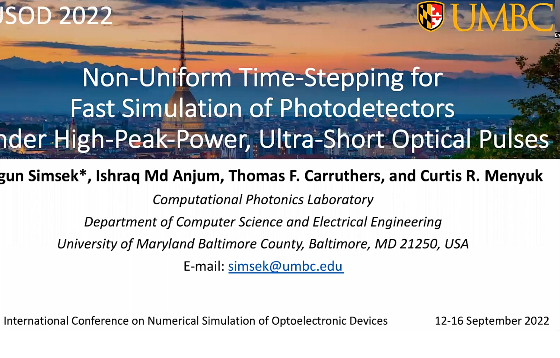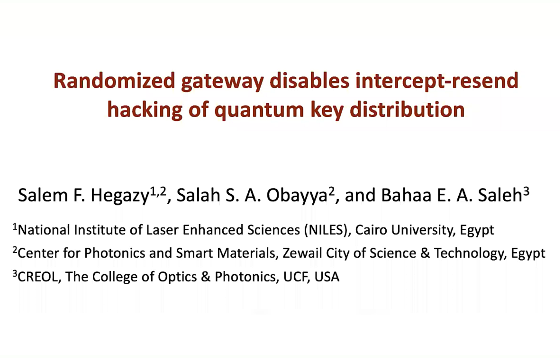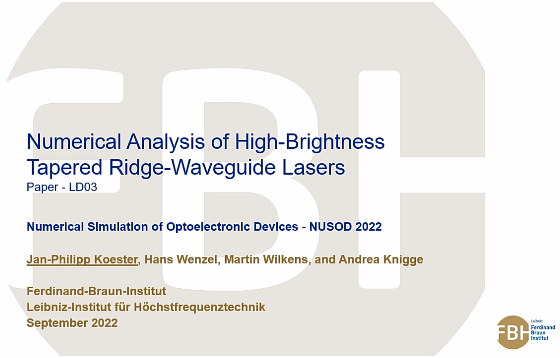Oral51 Videos



A novel non-uniform time-stepping procedure is developed to reduce the memory usage and simulation time—by two orders of magnitude—of photodetectors when detecting high-peak-power, ultra-short optical pulses. The proposed procedure can be used in other marching-on-in-time solvers to achieve the same for the simulations dealing with ultra-short pulses.
D02 – Electro-Optical Simulation and Characterization of DCR and secondary emission in SPADs
We demonstrate the use of simulations in the modeling and characterization of important aspects of Single Photon Avalanche Detectors (SPADs). Electrically, we discuss the use of drift-diffusion and avalanche triggering probability solvers and results for dark count rate (DCR) and their comparison to measurements. Optically, we discuss the use of full wave electromagnetic solvers to […]
D03 – 3D multiphysics transient modeling of vertical Ge-on-Si pin waveguide photodetectors
We report transient simulations of Ge-on-Si vertical pin waveguide photodetectors (WPDs), where the optical generation term used by the time-domain model is the FDTD solution of the electromagnetic problem treated as a spatially-distributed pulsed signal. This approach, validated against experimental measurements of the frequency response, paves the way to future studies of the dynamic response […]
D05 – Mode-Guided Infrared Absorption in Ge/SiO2 Grating for Large-Angle and Broadband Photodetection
The numerical simulation of the electromagnetic properties of the Ge/SiO2 grating structure with bottom distributed Bragg reflector. With mode guiding in Ge, the structure exhibits an absorption angle of 100° and broadband behavior from 1300 to 1500 nm.
IS01 – Network Authentication with Synchronized Chaotic Lasers
We numerically study a hardware method for network authentication, where a pair of matched (twins) chaotic lasers generate the same chaos when they synchronize, being subject to the same optical injection from a third chaotic laser. One of the lasers is in the secure environment, the other in the unsecure environment, and authorization is granted […]
IS02 – Exploring modern alternatives to the Whittaker-Shannon-Nyquist sampling theorem in THz Spectroscopy
We present simulations for a THz cross-correlation spectroscopy (THz-CCS) optical system. The aim is using compressed sensing (CS) to reconstruct the THz signal from a random under sampling of the signal and potentially replacing a delay stage unit of the THz-CCS system to increase robustness and cost-effectiveness of the optical system. We present results from […]
IS03 – Polarization-randomized gateway against detector-blinding hacks of quantum key distribution
A quantum key distribution system –employing a key time-bin qubit and a security-pass polarization-randomized qubit– is shown to overcome a wide class of intercept-resend attacks adopting the use of faked-state light; including attacks based on blinding of single-photon avalanche detectors (SPADs).
IS04 – All-optical AND Logic Gate Based on Semiconductor Optical Amplifiers for Implementing Deep Recurrent Neural Networks
The development of optical logic gates is a key factor for enabling next generation of computations in the context of Deep Learning and Quantum Computing. In this work, we introduce a scheme for the implementation of an all-optical AND logic gate, which makes use of semiconductor optical amplifiers (SOA) in cross-phase modulation configuration combined with […]
IS05 – Thermal crosstalk mitigation in a dual-drive Mach-Zehnder Modulator
Dual-drive, PIN-diode based Mach-Zehnder modulators are pivotal for power-efficient and cost-effective CMOS compatible optical transceivers with small footprints. However, the basic chip materials have substantial thermal conductance resulting in thermal crosstalk, which eventually deteriorates the modulator performance in terms of bandwidth and data transmission capabilities. In this work, we simulate and analyze the influence of […]
IS07 – OFDM Transmission using a Self-seeded ring Cavity based on a Semiconductor Optical Amplifier
This paper discusses the transmission of optical Orthogonal Frequency-Division Multiplexing (OFDM) format modulation in a resonant cavity based on a Semiconductor Optical Amplifiers Fiber Cavity Laser (SOA-FCL). The OFDM Subcarriers are configured and transmitted to fit the Cavity Resonance Modes (CRM). As a result, the authors show a novel principle of OFDM transmission in a […]
IS08 – Flat-band 8-Channel Optical MUX/DeMUX for Long Reach 400GbE Applications
We propose novel optical demultiplexer scheme for LR-8 applications, and theoretically verify flatband spectral response with the discrete 8-channel wavelengths. By the additional band rejection filter, non-continuous wavelength filtering response was achieved with spectral flatness and low crosstalk of < -15dB within an entire LR-8 targeted spectral range.
LD01 – Steady states in dynamical semiconductor laser models and their analysis
We present an algorithm for calculating steady states in the dynamic PDE model for SLs admitting gain compression, spatial hole burning, and multilevel carrier rate equations. Presented example simulations rely on 1(time)+1(space)-dimensional traveling-wave- and Lang-Kobayashi-type models.
LD02 – Microscopic modeling of interface roughness scattering and application to the simulation of quantum cascade lasers
The theory of interface roughness (IFR) scattering in semiconductor heterostructures is well established in the case of idealized abrupt interfaces. However, in reality, interfaces have a finite width, i.e. interfaces are graded. In such case, the effect of interface roughness, i.e. the breaking of in-plane invariance, a general framework has been lacking to describe the […]
LD03 – Numerical Analysis of High-Brightness Tapered Ridge-Waveguide Lasers
In this work, we present a simulation-based analysis of a CW driven tapered ridge-waveguide laser having a high lateral brightness of 5 W · mm−1mrad−1 at 2.5 W optical output power.
LD04 – Modeling carrier transport in mid-infrared VCSELs with type-II superlattices and tunnel junctions
Vertical-cavity surface-emitting lasers are promising light sources for sensing and spectroscopy applications in the midinfrared 3 ÷4 µm spectral region. A type-II superlattice active region is used for carrier injection and confinement, while a buried tunnel junction defines a current aperture, decreasing the series resistivity. Highly nanostructured to optimize device performance, mid-infrared VCSELs pose modeling […]
LD05 – Data-Driven Modeling of Non-Markovian Noise in Semiconductor Lasers
Non-Markovian noise degrades the coherence properties of semiconductor lasers and contributes significantly to broadening of the linewidth. Since modeling of such colored noise systems from first principles is not accessible, we aim for a data-driven modeling approach in which a system of stochastic rate equations shall be reconstructed from time series data.
LD06 – Relative intensity noise of injection-locked epitaxial quantum dot laser on silicon
This work investigates the relative intensity noise (RIN) characteristics of quantum dot (QD) lasers epitaxially grown on silicon subject to the optical injection. The effect of threading dislocation (TD), which acts as nonradiative recombination centers in the Shockley-Read-Hall (SRH) process, is considered in the rate equation model. The results reveal that the RIN is enhanced […]
LD07 – Physics-based time-domain modeling of VCSELs
This paper presents the results of a physics-based time-domain simulator for a vertical-cavity surface-emitting laser (VCSEL). We implemented a trapezoidal rule second order backward differentiation formula (TR-BDF2) to simulate the large signal response of the device under investigation, including the parasitic effects of the pin junction arising from an interplay of optical and carrier transport […]
LD08 – Modeling of THz Comb Emission in Difference-Frequency Quantum Cascade Lasers
The generation of terahertz (THz) frequency comb emission by intracavity difference frequency generation (DFG) in a mid-infrared (mid-IR) quantum cascade laser (QCL) is a promising alternative to direct THz QCL frequency comb generation. Concerning their room temperature operation capabilities, these devices are well suited for applications in rotational molecular spectroscopy and sensing. In order to […]
LD09 – Simulation of the Spectral Behavior in High-Power Distributed Feedback Lasers above Threshold
We report on the simulations of mode hopping behavior in semiconductor distributed feedback lasers with asymmetric facet reflectivities above threshold and its dependence on the phase between the grating and the high reflective facet.
LD10 – Effect of Self-Phase Modulation on The Signal Quality of Fourier Domain Mode-Locked Lasers
In this paper, the impact of self-phase modulation on the noise performance of Fourier Domain Mode-Locked (FDML) lasers is investigated. It is shown that under a relatively high fiber nonlinearity and/or intracavity signal amplitude, an excess amount of noise generation occurs, which can not only lead to poor signal quality, but also operational instability. Hence, […]
LED01 – First-principles computation of charge-carrier recombination coefficients in optoelectronic materials
Charge-carrier recombination plays a decisive role in determining the efficiency of optoelectronic materials and devices, but their accurate experimental measurements and interpretation are challenging. In this context, first-principles computation of charge-carrier recombination coefficients is particularly useful. It allows not only rigorous computation of the recombination rates, but also intuitive interpretation of the microscopic recombination mechanisms […]
LED02 – Carrier Transport in Multi Colour Deep Ultraviolet Light Emitting Diodes
Deep ultraviolet (DUV) light emitting diodes (LEDs) and lasers are enabled by high band gap Aluminium Gallium Nitride (AlGaN). The efficiency of recent multi quantum well (MQW) DUV emitters is still in the percent range which can be in part attributed to the hole injection. The hole injection and the carrier distribution in the high […]
LED04 – Development of time-dependent Exciton diffusion solver for modeling Triplet-Triplet Fusion Mechanism in OLEDs
In this work, we developed a both stable and time-dependent exciton diffusion model including singlet and triplet exciton coupled with a modified Poisson & drift-diffusion solver to demonstrate the mechanism of triplet-triplet fusion (TTF) OLEDs. Using this modified simulator, we can demonstrate the characteristics of OLEDs including current-voltage curve, quantum efficiency performance, time-resolved electroluminescence spectrum, […]
LED05 – Reliable prediction of the singlet-triplet gap in TADF molecules with GW/BSE approach
Organic light emitting diode (OLED) molecules that exhibit thermally activated delayed fluorescence (TADF) have emerged as a promising technology for various lighting and display applications. Such systems depend on low singlet-triplet gaps of the order of kT to allow reverse inter-system crossing. Here, we demonstrate the capability of a GW/BSE method to predict excitation energies […]
MM01 – Rigorous modal analysis of micro or nanoresonators
The most general motion of a system is a superposition of its normal modes, or eigenstates. We report our recent developments of a rigorous modal analysis of electromagnetic resonators, which is accurate even for geometries that have not been analyzed so far, e.g. 3D resonators made of dispersive media and placed in non-homogeneous backgrounds (on […]
MM02 – Carrier transport in (In,Ga)N quantum well systems: Connecting atomistic tight-binding electronic structure theory to drift-diffusion simulations
Understanding the impact of the alloy microstructure on carrier transport in (In,Ga)N/GaN quantum well systems is important for aiding device design. We study the impact that alloy fluctuations have on uni-polar carrier transport for both electrons (n-i-n junction) and holes (p-i-p junction) using a multiscale framework. To do so we connect an atomistic tight-binding model […]
MM03 – Implementation of Partially Reflecting Boundary Conditions in the Generalized Maxwell-Bloch Equations
Perfectly matched layer (PML) boundary conditions have been used for several decades for the simulation of open domains within the finite difference time domain (FDTD) method. In this paper, we report on a new PML-based partially reflecting boundary condition for the generalized Maxwell-Bloch equations that enables setting a certain value of reflectance R at the […]
MM04 – Simulation of ac conductivity of monolayer MoS2 at terahertz frequencies
We present a multiphysics numerical tool for calculating the terahertz (THz) conductivity of transition-metal dichalcogenides (TMDs). The tool combines the ensemble Monte Carlo (EMC) technique for carrier transport with a three-dimensional finite-difference-time-domain (FDTD) solver for electromagnetic fields. We use the coupled EMC–FDTD technique to calculate the frequency-dependent conductivity in the terahertz range for monolayer MoS2, […]
MM05 – Comparison of flux discretizations for varying band edge energies
Recently, a multiscale framework was developed where drift-diffusion is combined with atomistic tight-binding models. A naive flux discretization was proposed to tackle the problem of heavily fluctuating band edge energies which does not take into account mathematical complications. Here we would like to present several alternatives and compare them.
































